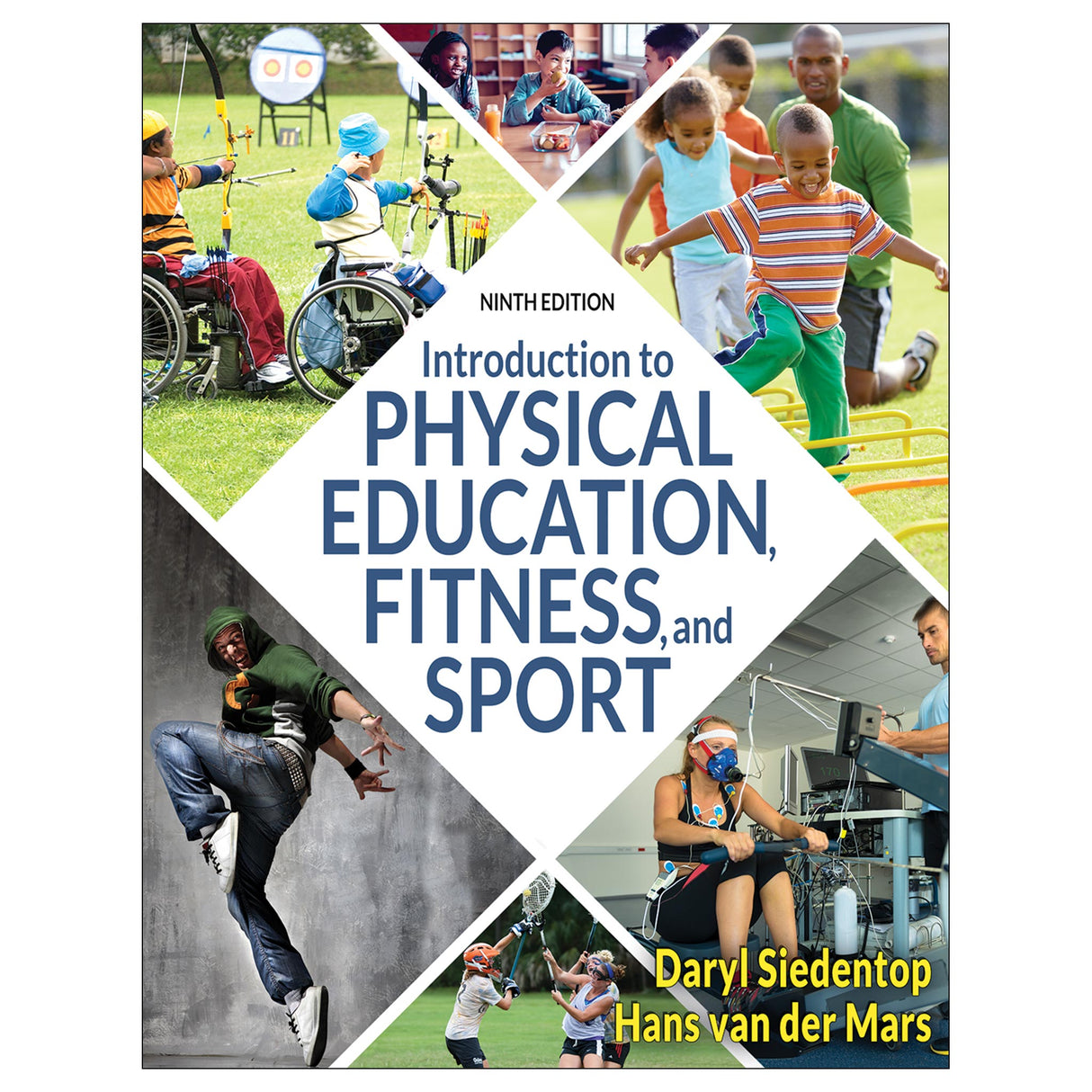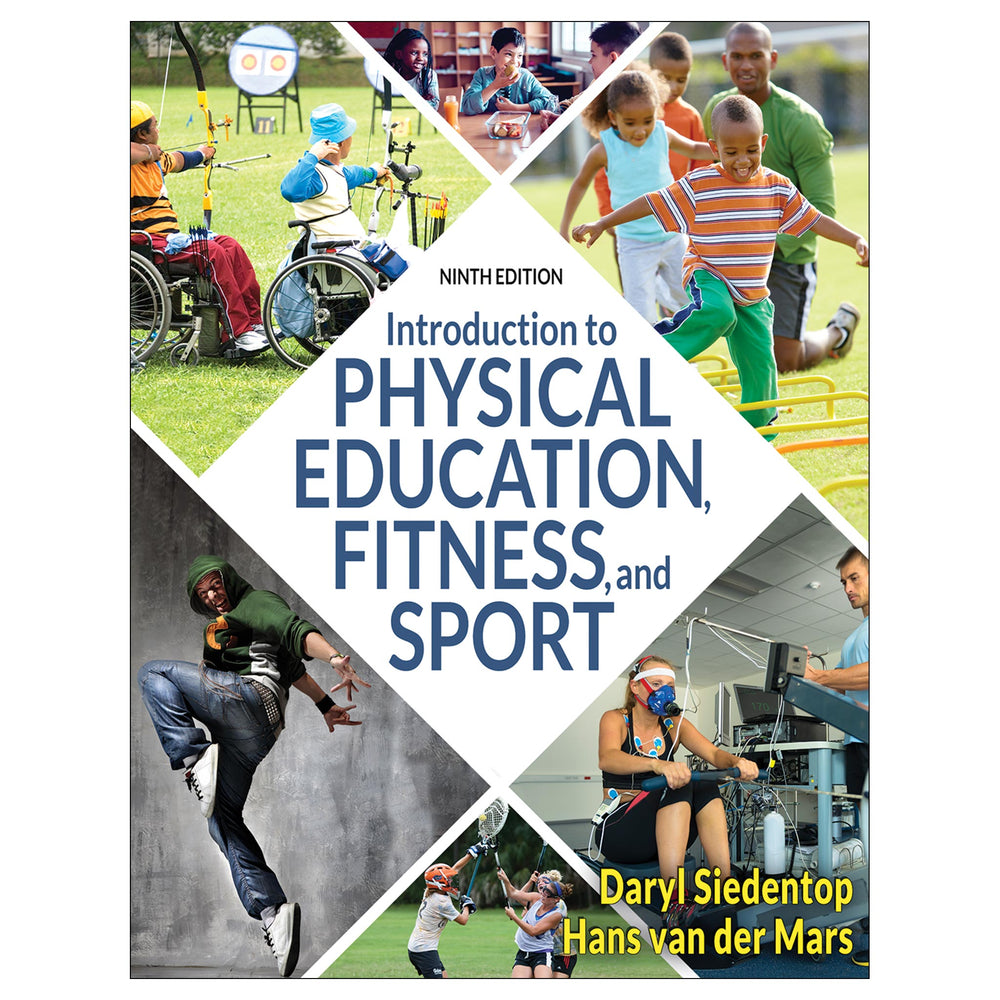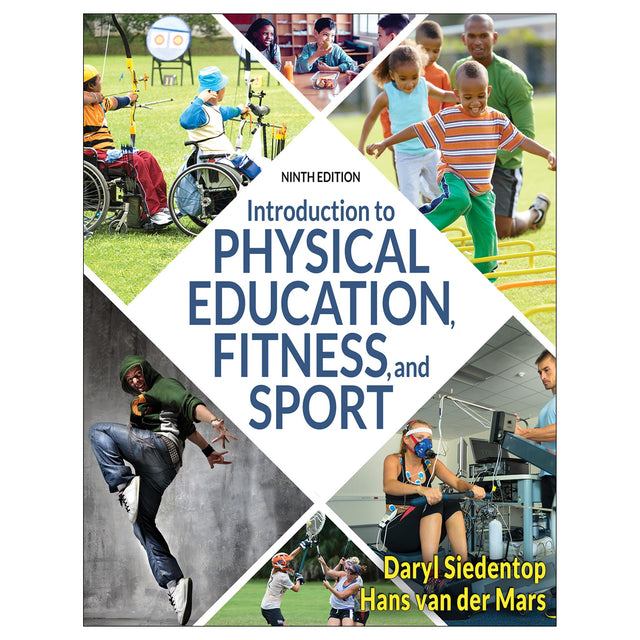Introduction to Physical Education, Fitness, and Sport-9th Edition
Author: Daryl Siedentop, Hans Van Der Mars
$117.00 USD
This book covers a broad spectrum of careers and professions, including those in physical education, health, dance, fitness, sport, recreation, athletic training, and athletic administration. The authors provide an overview of the respective professions and offer a deep dive into individual careers. In addition, the text explores the role of public policy across local, state, and federal levels, noting how various physical activity professions are affected by regulations.
New content in this edition includes the following:
- Five new chapters cover dance education, recreational leadership, health education, contemporary physical education curriculum models, and exemplary physical education programs.
- Updated content on how economic, racial, and ethnic disparities affect physical activity and physical activity professions will help students anticipate real-life issues.
- New evidence, data, and information throughout the text will help students understand the issues, problems, and programmatic solutions in the various fields as they prepare to meet and solve those problems.
- The expanded and updated physical education chapters reflect current trends and developments.
All chapters throughout the text have been updated to reflect the most current information on the topics. And the book’s web-based ancillaries, which include a range of instructor tools, have also been revised and expanded.
Introduction to Physical Education, Fitness, and Sport is organized into six parts:
- Part I provides a thorough understanding of the health issues related to physical inactivity and of the evolution of physical activity programs.
- Parts II, III, and IV focus on concepts, programs, professions, and barriers to overcome in physical education, fitness, and sport, respectively.
- Part V delves into the allied physical activity professions of dance and dance education, recreation, and health education, exploring the concepts, professions, and issues in each area.
- Part VI tackles the subdisciplines of kinesiology that support physical activity, such as exercise physiology, sport pedagogy, sport and exercise psychology, sport philosophy, biomechanics, and more.
Ultimately, this book will help new generations of physical activity professionals provide positive solutions to the problems that exist in their fields and to make lifelong impacts on their students.
Audience
This text targets undergraduate and graduate students in kinesiology who are exploring or preparing for the professions of physical education, health, dance, fitness, sport, recreation, athletic training, or athletic administration.Chapter 1. The Dilemma of Our Times: Life Span Physical Activity and the Obesity Health Crisis
Trends in Sugary Drink and Fast Food Consumption
Federal and State Legislation to Address Childhood Nutrition and Wellness
The Costs of Overweight and Obesity
National Goals for Physical Activity in Schools and Beyond
The National Physical Activity Plan
Grading Progress on Physical Activity
Summary
Discussion Questions
Chapter 2. Life Span Physical Activity: A Revolution Not Limited by Age or Gender
The Early Years
Youth: The Transition Years
Young Adulthood
Older Adulthood
The New Settings for Physical Activity
The Emerging Characteristics of Life Span Physical Activity
Confronting Major Issues
Summary
Discussion Questions
Chapter 3. The Evolution of Physical Activity Philosophies and Programs
Gymnastics Philosophies and Systems: The Beginning of Physical Education in America
The Emergence of Physical Activity in American Physical Education
The Emergence of Fitness
The Emergence of Organized Sport in America
Sport on College Campuses
Sport During the Depression, World War II, and Beyond
Philosophical Influences in American Physical Education, Fitness, and Sport
The Emergence of Physical Activity for Girls and Women
Recent Philosophical Influences on Physical Activity
Summary
Discussion Questions
Chapter 4. Developing an Infrastructure to Support Physical Activity and Healthy Lifestyles
Physical Fitness and Physical Activity: Whose Responsibility?
National-Level Efforts to Support Physical Activity Infrastructures
State-Level Efforts to Support Physical Activity Infrastructures
Local Efforts to Support Physical Activity Infrastructures
Allied Fields Supporting Physical Activity Infrastructure
Six Crucial Themes Defining Our Present and Future
Summary
Discussion Questions
Part II. Physical Education
Chapter 5. Basic Concepts of Physical Education
20th-Century Philosophical Influences on Physical Education
National Physical Education Goals and Content Standards
What Is the Subject Matter of Physical Education?
Physical Education and Physical Activity: The Same or Different?
Inclusion of Students With Disabilities in Physical Education
Summary
Discussion Questions
Chapter 6. Contemporary Curriculum and Instruction Models
The Skill Themes Model
Health-Optimizing Physical Education
Conceptual Physical Education
Teaching Personal and Social Responsibility
Sport Education
Games-Based Models for Teaching Sport Games
Adventure Education
The Eclectic Curriculum
Summary
Discussion Questions
Chapter 7. The Physical Education Profession
The Physical Education Teacher
Preparing to Become a Physical Education Teacher
Physical Education Teachers as Campus-Level Physical Activity Leaders
Technology in Physical Education
Summary
Discussion Questions
Chapter 8. Exemplary Physical Education Programs
The Active and Healthy Schools Program
A High School Program That Individualizes Students’ Activity Experiences
A Rural School’s Effort to Maximize Campus-Based Physical Activity Beyond Physical Education
A High-School Program Blending Health and Wellness, Outdoor Pursuits, and Sport
A Districtwide Healthy Lifestyles Curriculum
A Middle School With a Strong Focus on Learning Personal and Social Responsibility Skills
A High School Program With an Outdoor Pursuits Option
A Research-Based National Elementary School Program
A District-Level Initiative Linking Physical Education With the Community
A High School Program With Sport Education as the Central Focus
A High School Physical Education Program With Proficiency Expectations
What Makes These Programs Work?
A State Approach to Revitalizing High School Physical Education
Building a Vision for the Future
Rethinking Secondary School Physical Education
Legislative Efforts to Support Physical Education
Quality Physical Education Programs—Moving Forward
Summary
Discussion Questions
Chapter 9. The Future of Physical Education: Problems and Barriers to Overcome
Improving Physical Education Through Establishing Strong State-Level Legislation
Consequences of Weak or Nonexistent State-Level Policies
General Problems in Physical Education
Issues in Elementary School Physical Education
Issues in Secondary School Physical Education
The Future of Physical Education in a Sport and Fitness Culture
Becoming Architects of a Thriving Physical Education Profession
Summary
Discussion Questions
Part III. Fitness
Chapter 10. Basic Concepts of Fitness and Physical Activity
Understanding Fitness and Physical Activity
Cosmetic Fitness
The Dose–Response Debate
The FITT Formula
The Social Gradient in Health and Fitness
Fitness-Training Concepts and Principles
The Measurement of Fitness and Physical Activity
Summary
Discussion Questions
Chapter 11. Fitness and Physical Activity Programs and Professions
Fitness Levels Among Children and Adolescents
Physical Activity Patterns Among Children and Adolescents
Adult Fitness Levels and Activity Patterns
Fitness and Activity Patterns Among Older Adults
Fitness and Physical Activity for People With Disabilities
Worksite Fitness and Wellness Programs
National Efforts to Promote Fitness and Physical Activity
Legislative Efforts to Improve Child and Youth Fitness
Physical Fitness Instruction: By Whom?
Summary
Discussion Questions
Chapter 12. Problems and Barriers to Overcome in Fitness
The Complexity of Dealing With the Obesity Epidemic
The Costs of Inadequate Health-Related Fitness
Precipitating Factors Related to Overweight and Obesity
Developing Self-Efficacy for Physical Activity
Developing a Fitness-Educated Public
Persistent Inequity Issues in Fitness and Activity
Certification of Fitness Leaders
Fitness Issues in Physical Education
Fitness and Aging: Changing Views and Expectations
Summary
Discussion Questions
Part IV. Sport
Chapter 13. Basic Concepts of Sport
Sport: The Natural Religion
Leisure, Play, Games, and Competition
The Institutionalization of Sport
Sport Spectating
Sport Aesthetics
Sport Ethics
The Developmental Potential of Sport
Inequities in Sport
Summary
Discussion Questions
Chapter 14. Sport Programs and Professions
Child and Youth Sport
Interscholastic Sport
Collegiate Sport Programs
Professional Sport
Organized Recreational Sport
Sport for People With Disabilities
Masters or Veterans Sport
Nonparticipant Sport Involvement
Sports Medicine and Athletic Training
Sport and Technology
Summary
Discussion Questions
Chapter 15. Problems and Barriers to Overcome in Sport
Child and Youth Sport
Interscholastic Sport
Intercollegiate Sport
Sport Systems
Summary
Discussion Questions
Part V. The Allied Physical Activity Professions
Chapter 16. Dance and Dance Education: Concepts, Professions, and Issues
Gayle Kassing, PhD
Defining Dance and Dance Education
Dance Forms and Genres
Dance Content Knowledge
Teaching Dance in the 21st Century
Sectors of Dance Education and Overarching Issues
Future Directions for Dance Education in the 21st Century
Summary
Discussion Questions
Chapter 17. Recreation: Concepts, Professions, and Issues
Eric Legg
Community Parks and Recreation
Key Concepts
History of Leisure, Recreation, and Play
Recreation Providers Today
Recreation Spaces and Programs
Current Trends and Issues in Recreation
Summary
Discussion Questions
Chapter 18. Health Education: Concepts, Professions, and Issues
Sarah Benes, EdD, MPH, CHES, and Holly Alperin, EdM, MCHES
Health Education Defined
The Need for Health Education
Benefits of Health Education
Components and Principles of Effective Health Education
Skills for Health Education Teachers
Current Barriers and Issues
Conclusion
Summary
Discussion Questions
Part VI. Kinesiology: The Scientific Foundation of Human Movement
Chapter 19. The Subdisciplines of Kinesiology That Support Physical Activity Professions
Exercise Physiology
Biomechanics
Motor Behavior
Sport and Exercise Psychology
Sport Pedagogy
Sport Sociology
Sport Humanities Subdisciplines
Summary
Discussion Questions
Dance and Dance Education Standards for College and Career Readiness
Life Span Physical Activity and the Obesity Health Crisis
Professional Profile: Parks and Wildlife Management
Skills for Health Education Teachers
All ancillaries are free to adopting instructors through HKPropel.
Instructor guide. Includes an introduction, a sample course syllabus, and chapter objectives and activities as well as several course assignments with rubrics to assign at the completion of each of the book’s six parts. In addition, optional sample out-of-class assignments are included.
Test package. Contains 483 questions, in short-answer and essay, true-false, fill-in-the-blank, and multiple-choice formats, making it easy to create quizzes and tests for students.
Presentation package. Features more than 300 PowerPoint slides of text, artwork, and tables from the book that can be used for class discussion and presentation. The slides in the presentation package can be used directly within PowerPoint or printed to make handouts for students. Instructors can easily add, modify, and rearrange the order of the slides.





